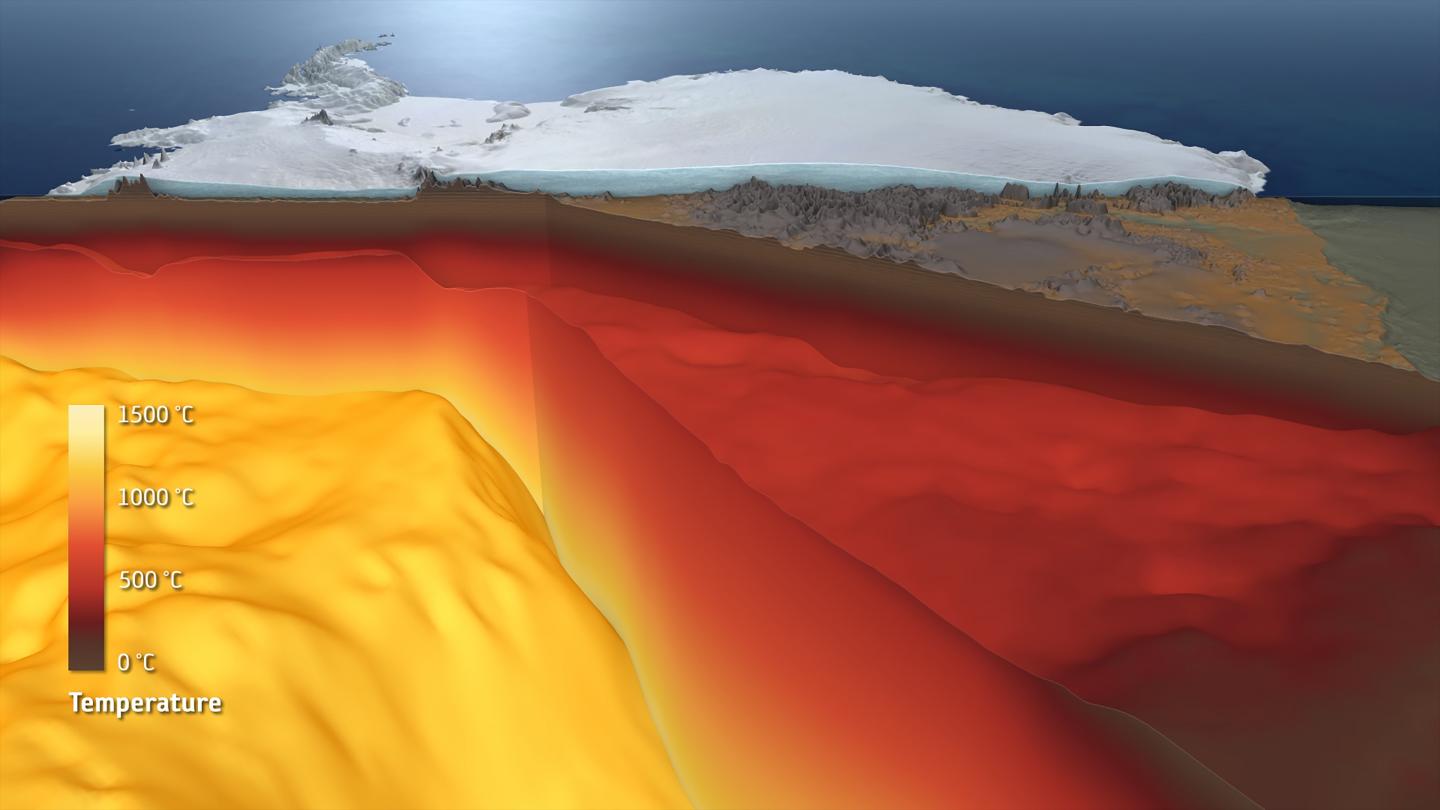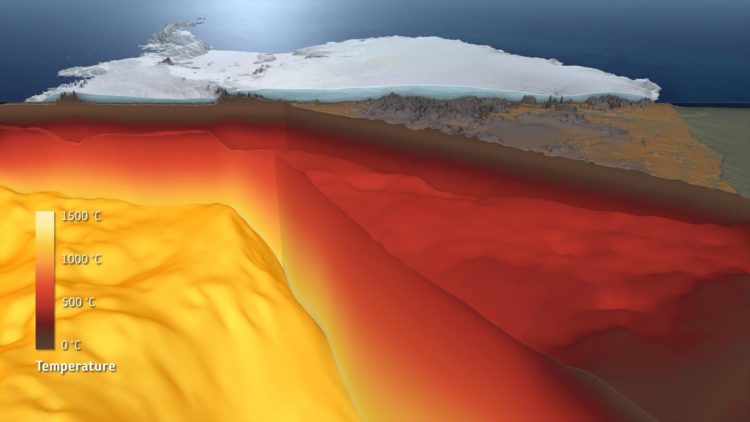European Space Agency publishes a 3D model of the Antarctic

Credit: © Planetary Visions (credit: ESA/Planetary Visions)
The Antarctic is one of the parts of earth that we know the least about. Due to the massive ice shield, the collection of geophysical information on site is extremely difficult and expensive. Satellite data from the European Space Agency (ESA) has now been used as the basis for new insights on the deep structure of the continent. Scientists from Kiel University (CAU) recently published their discoveries in the Journal of Geophysical Research: Solid Earth in cooperation with scientists from the British Antarctic Survey, Great Britain, and Delft University of Technology in the Netherlands.
Looking into the deep from space
The newly evaluated data from the ESA’s GOCE satellite mission dedicated to the earth’s gravitational field, combined with seismological models, enables unprecedented insights into the lithosphere, which consists of the crust and the earth’s upper mantle below the frozen continent. To do so, Folker Pappa, doctoral researcher at Kiel University and lead author of the study, along with Jörg Ebbing, Professor for Geophysics at Kiel University, used special gradient data of the satellite, among other information: “This allows a much greater level of detail when analysing deep earth structures,” says Pappa. It enables the researchers to draw conclusions about such things as the depth of the transition from crust to mantle – and these measurements are dramatically different over the 14 million square kilometre region. “Under West Antarctica, which is geologically young, the earth’s crust is comparatively thin with about 25 kilometres, and the earth’s mantle is viscous at a depth of less than 100 kilometres. East Antarctica, on the other hand, is an old cratonic shield and more than one billion years old. Here, the mantle rocks still have solid properties at a depth of more than 200 kilometres.”
Representation of the deep 3D structure of the Antarctic now also permits new findings about the so-called glacial-isostatic adjustment, explains co-author Professor Wouter van der Wal from Delft University of Technology: “This is a key process that determines how the continent responds to current and past ice sheet thinning. We found large variations in mantle temperature beneath the continent, which lead to the uplifting and subsiding of the ground with very different speeds across the continent. These new constraints on crustal and lithosphere thickness are also pivotal in the quest to estimate Antarctic geothermal heat flux and how it affects subglacial melting and ice sheet flow.”
“These are natural interactions between the ice and the solid earth. Until now, it was not possible to examine these processes more closely in the Antarctic in detail due to a lack of earth models,” added Pappa. His personal highlight are the Gamburtsev Subglacial Mountains that are still barely explored and over three thousand metres high: “The solid earth is the thickest here, at around 260 kilometres. This is an exciting structure, and we don’t know exactly what it looks like because the mountain range is completely covered with ice shields.”
Antarctica as a 3D model and its connection to other continents
The research was funded by the European Space Agency within the projects GOCE+Antarctica and 3D Earth. The international consortium of both projects consists of nine institutions in six European countries. “3D Earth offers us tantalising new geophysical findings about the deep structure and development of Antarctica. These new models showing the thickness of the crust and the lithosphere are crucial to understanding the fundamental composition and tectonic architecture of the Antarctic, for example,” emphasises Dr Fausto Ferraccioli, head geophysicist at the British Antarctic Survey and co-author of the study. “Further findings that we can derive from the study concern are the former connections between Antarctica and other continents such as Australia, Africa and India,” said Ferraccioli.
“We are finally getting to know the Antarctic properly,” says Ebbing. In addition to the temperature distribution, the researchers have also determined other properties of the solid earth, such as the composition and the rock density.
Part of the project is an impressive 3D model of the Antarctic, created by the ESA. ESA’s Roger Haagmans noted: “These are important findings also in the context of understanding sea-level change as a consequence of ice loss from Antarctica. When ice mass is lost, the solid Earth rebounds and this effect needs to be accounted for in ice volume changes. This can be better determined once the structure and composition of the Earth interior are better understood.”
###
Original publication:
Pappa, F., Ebbing, J., Ferraccioli, F., & van der Wal, W. ( 2019). Modeling satellite gravity gradient data to derive density, temperature, and viscosity structure of the antarctic lithosphere. Journal of Geophysical Research: Solid Earth, 124. https:/
Pictures are available for download:
http://www.
Doctoral researcher Folker Pappa measured the Antarctic.
© Claudia Eulitz, Kiel University
http://www.
The continent Antarctica.
© Planetary Visions (credit: ESA/Planetary Visions)
http://www.
The deep structure of the continent Antarctica.
© Planetary Visions (credit: ESA/Planetary Visions)
3D model of the Antarctic:
http://www.
© Planetary Visions (credit: ESA/Planetary Visions)
Further information:
GOCE+Antarctica: http://www.
3D Earth: http://www.
Press release of ESA:
http://www.
Contact:
Folker Pappa
Institute of Geosciences
Kiel University, Germany
phone: +49 431 880-4562
email: [email protected]
Prof. Dr. Jörg Ebbing
Institute of Geosciences
Kiel University, Germany
phone: +49 431 880-2832
email: [email protected]
Kiel University
Press, Communication and Marketing, Dr Boris Pawlowski, Text/editing: Claudia Eulitz
Postal address: D-24098 Kiel, Germany, Telephone: +49 431 880-2104, Fax: +49 431 880-1355
E-mail: [email protected], Internet: http://www.
Facebook: http://www.
Media Contact
Folker Pappa
[email protected]
49-431-880-4562
Original Source
https:/
Related Journal Article
http://dx.





